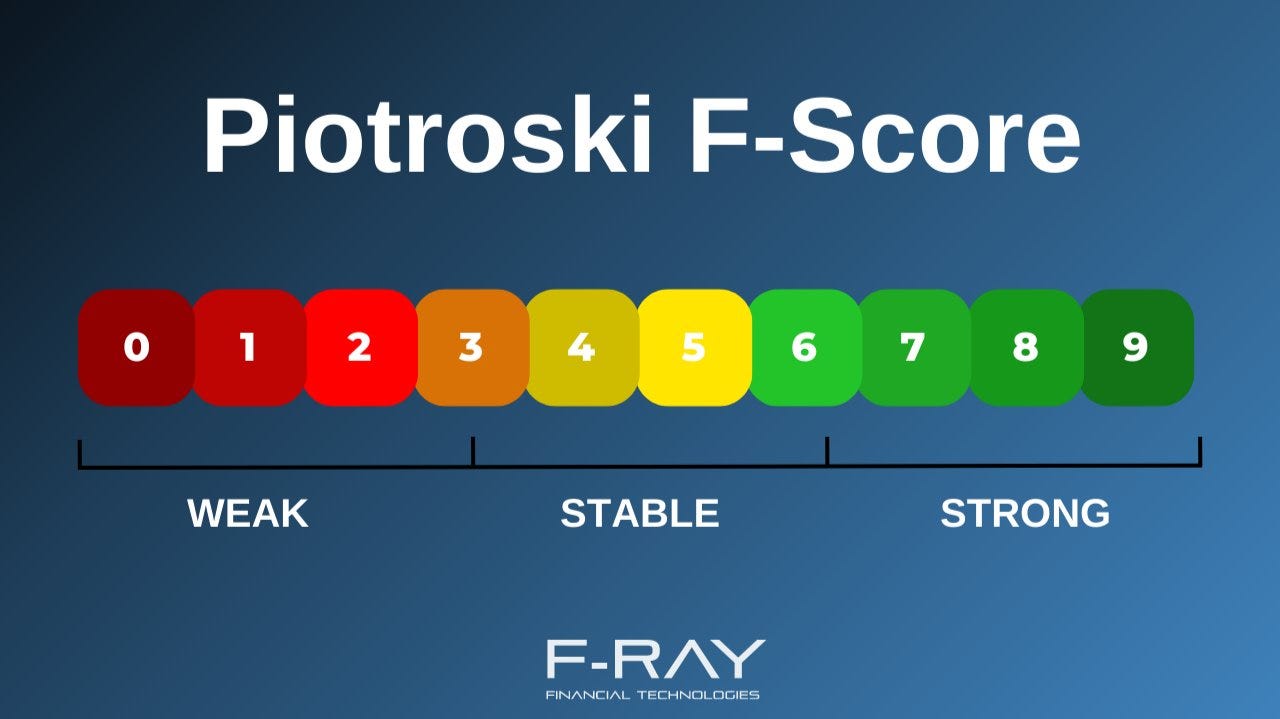🎓 Are You Using the Piotroski F-Score to Spot Strong Stocks?
How this 9-point scoring system helps identify financially strong companies and avoid weak investments
When looking for good investments, it's important to know if a company is financially healthy. In 2000, accounting professor Joseph Piotroski created the Piotroski F-Score, a system that helps investors separate strong companies from weak ones.
This score looks at nine financial factors and gives each company a score between 0 and 9. A higher score means a company is in better shape, while a lower score could be a warning sign.
How the Piotroski F-Score works
The F-Score is based on nine simple financial checks, grouped into three categories: profitability, debt and liquidity, and efficiency.
1️⃣ Profitability (3 points)
✔️ Positive Return on Assets (1 point) – The company is making a profit.
✔️ Positive Operating Cash Flow (1 point) – The business is generating real cash from its operations.
✔️ Higher ROA than last year (1 point) – The company’s profits are improving.
These checks show if a company is making money and improving its financial results.
2️⃣ Debt & Liquidity (3 points)
✔️ Operating Cash Flow is higher than net income (1 point) – The company’s cash flow is strong and not just based on accounting numbers.
✔️ Less long-term debt than last year (1 point) – The company is reducing its debt.
✔️ A higher current ratio than last year (1 point) – The company is in a better position to pay short-term bills.
These points help measure if a company is managing its debt well and staying financially stable.
3️⃣ Efficiency & Stability (3 points)
✔️ No new shares issued (1 point) – The company is not diluting existing shareholders.
✔️ Higher gross margin than last year (1 point) – The company is making more money on its sales.
✔️ Higher asset turnover than last year (1 point) – The company is using its assets more efficiently.
A company that scores well here is managing its costs and assets wisely, which is a good sign for long-term success.
What the score means
After checking all nine factors, companies get a total score between 0 and 9:
🚨 0 - 3 (Weak): The company may be struggling financially and could be risky.
⚖️ 4 - 6 (Stable): The company has both strong and weak points but is in decent shape.
✅ 7 - 9 (Strong): The company is financially solid and well-managed.
Source: F-Ray Financial Technologies
Examples of companies and their scores
Here are real-world examples of companies with weak, stable, and strong Piotroski F-Scores (source: gurufocus.com):
🚨 Weak (0-3) – Companies With Financial Struggles
MicroStrategy (MSTR) – 2
Intel (INTC) – 3
These companies may have high debt, low profits, or cash flow problems, making them riskier investments.
⚖️ Stable (4-6) – Companies With Mixed Strengths
Tesla (TSLA) – 4
Hims & Hers (HIMS) – 5
Amazon (AMZN) – 6
These companies have some strong points, but there may be areas of concern investors should look into further.
✅ Strong (7-9) – Companies in Great Financial Shape
Apple ($AAPL) - 7
Mastercard ($MA) – 8
KLA Corporation ($KLAC) – 9
These companies are profitable, manage their finances well, and continue to grow efficiently.
How we use the Piotroski F-Score
At The Future Investors, we use the Piotroski F-Score as part of our research to check a company’s financial strength. While it’s not the only factor we consider, it helps us quickly spot strong businesses and avoid weaker ones.
Do you use the Piotroski F-Score in your investing strategy? Let us know in the comments!
Thank you for reading! 🙏
We put a lot of love into creating this post for you. If you enjoyed it, feel free to click the ❤️ button so more people can discover it on Substack.
Don’t hesitate to share your thoughts in the comments — we’d love to hear from you 💬
Disclaimer:
The information and opinions provided in this article are for informational and educational purposes only and should not be considered as investment advice or a recommendation to buy, sell, or hold any financial product, security, or asset. The Future Investors does not provide personalized investment advice and is not a licensed financial advisor. Always do your own research before making any investment decisions and consult with a qualified financial professional before making any investment decisions. Please consult the general disclaimer for more details.




